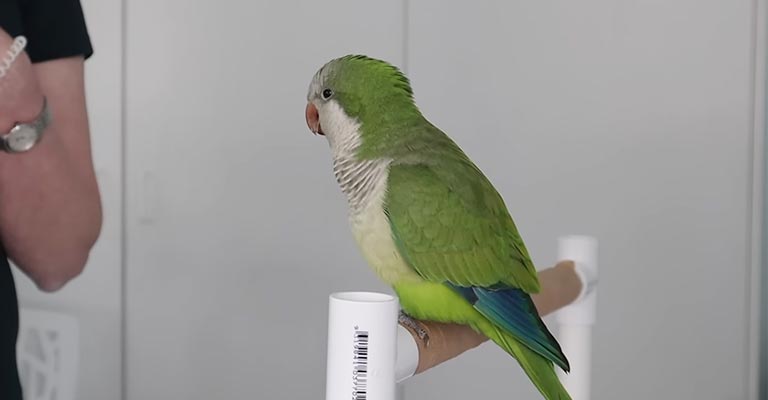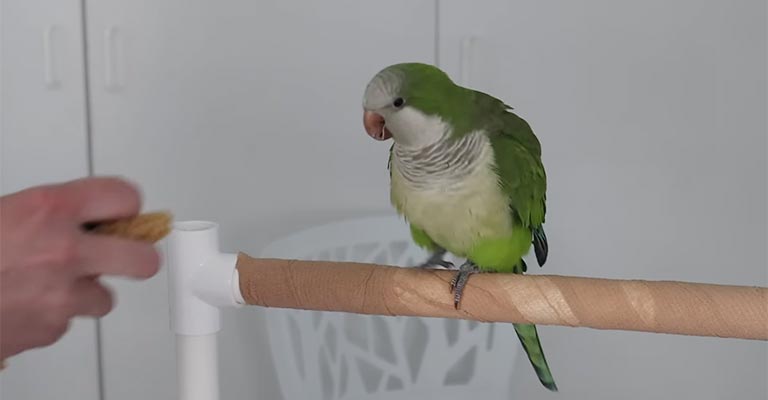Quaker parrots, known for their charming personalities and vibrant plumage, have a unique behavior that often leaves bird enthusiasts intrigued – puffing up.
This peculiar behavior can be both endearing and puzzling, as these small parrots suddenly transform into fluffy, round balls of feathers.
Why do Quaker parrots puff up? In this article, we delve into the fascinating world of Quaker parrots to uncover the reasons behind their distinctive habit of puffing up.
Is it a sign of comfort, distress, or simply a way to regulate body temperature? Understanding this behavior can provide valuable insights into the emotions and well-being of these intelligent birds.
We’ll explore the various scenarios in which Quaker parrots puff up, from relaxation and social interactions to potential health concerns. By the end, you’ll have a deeper appreciation for the charming, enigmatic nature of these feathered companions.

Why Do Quaker Parrots Puff Up?
One primary reason why Quaker parrots puff up their feathers is to regulate their body temperature. These birds are native to South America, and they have adapted to a wide range of climates.
By fluffing up their feathers, they create an insulating layer of air, which helps to trap warmth close to their bodies. This is particularly important in cooler environments or during chilly nights.
When Quaker parrots feel cold, they instinctively puff up to conserve heat and maintain their ideal body temperature. It’s essential for their well-being, as prolonged exposure to low temperatures can be detrimental to their health.
So, if you notice your Quaker parrot puffing up on a cold day, consider providing a source of warmth or adjusting their environment to keep them comfortable. Here are the other reasons:
Relaxation and Comfort
In many cases, puffing up is a sign of relaxation and comfort for Quaker parrots. When these birds feel safe and secure, they often fluff up their feathers as a way of unwinding. It’s akin to curling up under a cozy blanket, and it suggests that your parrot is content and at ease.
You may observe your Quaker parrot puffing up while perched on a favorite spot, during quiet moments, or even when they’re enjoying your company.
This behavior signifies that they trust their surroundings and are in a state of relaxation. As a bird owner, witnessing this behavior is a heartwarming confirmation that your pet is happy and content in their environment.
Social Interaction
Puffing up can also be a form of social interaction and communication among Quaker parrots. When these parrots are engaging with each other or their human companions, they may puff up their feathers to convey various messages.
In a social context, puffing up can be a way for Quaker parrots to assert dominance or show submission to others.
During courtship and bonding rituals, they may puff up as part of their elaborate displays to attract potential mates or to strengthen existing bonds. This behavior helps them communicate their intentions and emotions to their fellow parrots.
When interacting with your Quaker parrot, observe the context in which they puff up their feathers. It can provide valuable insights into their feelings and the dynamics of your relationship with them.
Emotion Expression
Like many parrot species, Quaker parrots are highly expressive creatures. They use body language to convey a wide range of emotions, and puffing up is one of the key indicators. This behavior can signify not only comfort and relaxation but also various emotional states.
For instance, if your Quaker parrot is feeling anxious or threatened, they may puff up their feathers to appear larger and more intimidating.
This is a defensive posture that signals their discomfort or fear. In contrast, when they’re excited, happy, or curious, puffing up can be a way to express their positive emotions.
Understanding your Quaker parrot’s emotional state through their feather puffing can help you respond appropriately to their needs and provide the right support and reassurance.
Health and Illness
While feather puffing is a common and often benign behavior, it can sometimes be an indication of health issues.
If your Quaker parrot is consistently puffing up, and there are no apparent environmental factors contributing to this behavior, it’s crucial to consider the possibility of an underlying health problem.
Quaker parrots are known for their resilience, but they can fall ill like any other pet. Conditions such as respiratory infections, internal parasites, or metabolic issues can manifest as increased feather puffing.
If you notice persistent feather puffing along with other concerning signs like reduced appetite, lethargy, or changes in droppings, it’s imperative to seek immediate veterinary care.
Regular check-ups with an avian veterinarian and a vigilant eye for changes in behavior can help ensure the well-being of your Quaker parrot.
Nesting Behavior
Puffing up is also associated with nesting behavior in female Quaker parrots. When a female Quaker parrot is preparing to lay eggs and care for her young, she will puff up her feathers to create a comfortable and insulated nest.
This behavior is part of her instinctual maternal role, and it helps regulate the temperature inside the nest cavity.
Male Quaker parrots may also participate in nest-building and incubating eggs, and they may puff up their feathers for similar reasons during this phase of their reproductive cycle.
If you plan to breed Quaker parrots, understanding their nesting behavior and providing appropriate nesting materials is crucial for their breeding success.
How Do Parrots Show Anger?

Understanding how parrots express their anger is essential for responsible pet ownership and maintaining a harmonious relationship with your feathered friend. Let’s explore how parrots show anger and what you can do to address and prevent this emotion.
Vocalizations
One of the most common ways parrots express anger is through vocalizations. When a parrot is upset or frustrated, they may become louder and produce harsher, screeching sounds.
These vocalizations can be startling and uncomfortable, and they serve as a clear indicator of their displeasure.
If your parrot is frequently making loud and aggressive vocalizations, it’s essential to assess the underlying causes of their anger. It could be related to their environment, interactions with other pets or people, or changes in their routine.
Aggressive Posture
Angry parrots may adopt aggressive body postures to convey their displeasure. They may puff up their feathers to appear larger, raise their wings, or fan their tail feathers. These physical displays are intended to intimidate and signal their discomfort or irritation.
If your parrot assumes an aggressive posture, it’s essential to give them space and avoid any actions that might escalate their anger. Attempting to handle or interact with an angry parrot can result in bites or further aggressive behavior.
Body Language
In addition to their posture, parrots use various body language cues to express anger. Enlarged pupils can indicate heightened stress or discomfort.
The feathers on top of their head may stand on end when they’re angry. Restless movements can be a sign of frustration.
Understanding these body language signals is crucial for gauging your parrot’s emotional state and taking appropriate actions to address their anger.
Biting and Aggression
Parrots may resort to biting when they are angry or feeling threatened. Biting is a natural form of defense for them, and it serves as a clear sign of their anger or distress.
If your parrot bites, it’s essential not to respond with anger or punishment. Instead, provide a calm and non-threatening response.
Avoid reacting with loud noises, as this can escalate the situation. If the biting becomes a frequent issue, consult with an avian behaviorist to address the underlying causes and find effective solutions.
Destructive Behavior
Angry parrots may engage in destructive behavior as an outlet for their frustration. This can include chewing on cage bars, tearing up toys, or damaging their surroundings.
Providing ample mental and physical stimulation can help prevent destructive behavior. Parrots need opportunities for play and exercise, so be sure to offer a variety of toys and activities to keep them engaged.
Withdrawal and Avoidance
When parrots are angry or upset, they may withdraw from social interactions and avoid human contact. They may perch away from you, turn their back, or refuse to step onto your hand or finger.
If your parrot is exhibiting avoidance behaviors, it’s essential to give them space and time to calm down. Rushing or forcing interactions when they’re upset can exacerbate their anger. Patience and respect for their boundaries are key.
FAQs
Why do Quaker parrots puff up?
Quaker parrots puff up primarily as a way to regulate their body temperature. Puffing up creates a layer of trapped air that acts as insulation, helping them stay warm in cooler environments.
Is puffing up a sign of illness in Quaker parrots?
If your Quaker parrot is consistently puffed up, lethargic, or displaying other abnormal behaviors, it may be a sign of illness, and it’s advisable to consult with a veterinarian for a thorough examination.
Do Quaker parrots puff up when they are scared or stressed?
Yes, Quaker parrots may puff up in response to stress, fear, or anxiety. Puffing up can make a bird appear larger, potentially deterring perceived threats.
Can environmental factors affect a Quaker parrot’s puffing behavior?
Absolutely. Changes in environmental conditions, such as temperature fluctuations, drafts, or sudden loud noises, can influence a Quaker parrot’s tendency to puff up.
How can I tell if my Quaker parrot is puffing up for a normal reason or due to illness?
Monitoring the overall behavior of your Quaker parrot is crucial. If puffing up is occasional, especially in response to environmental factors, it’s likely a normal behavior.
Conclusion
The act of Quaker parrots puffing up their feathers is a multi-faceted behavior that can be driven by a range of factors. It serves as a versatile communication tool that reflects their emotional state, social interactions, and even their physiological needs.
Whether it’s a sign of contentment, a way to conserve warmth, or an expression of anxiety, understanding why Quaker parrots puff up can help bird owners and enthusiasts better care for and bond with these delightful creatures.
By paying close attention to their body language and the context in which they puff up, you can ensure their comfort, and address any potential health concerns.
So, the next time you witness your Quaker parrot fluffing up its plumage, remember that it’s not just a cute spectacle; it’s a window into their world, a testament to their adaptability, and a reminder of the intricate and beautiful nature of these endearing birds.